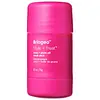What's inside
What's inside
 Key Ingredients
Key Ingredients

 Benefits
Benefits

 Concerns
Concerns

 Ingredients Side-by-side
Ingredients Side-by-side

Ricinus Communis Seed Oil
MaskingCoco-Caprylate/Caprate
EmollientEuphorbia Cerifera Wax
Vitis Vinifera Seed Oil
EmollientHydrogenated Castor Oil
EmollientOleic/Linoleic/Linolenic Polyglycerides
EmollientStearyl Behenate
EmollientCopernicia Cerifera Wax
Helianthus Annuus Seed Wax
Skin ConditioningRosa Canina Fruit Oil
EmollientCocos Nucifera Oil
MaskingArgania Spinosa Kernel Oil
EmollientGlyceryl Stearate Se
EmulsifyingPrunus Domestica Seed Oil
Skin ConditioningCitrus Junos Peel Extract
Skin ConditioningOlea Europaea Oil Unsaponifiables
Skin ConditioningShorea Robusta Resin
TonicRhus Verniciflua Peel Wax
Kaolin
AbrasiveHelianthus Annuus Seed Oil
EmollientPanthenol
Skin ConditioningNiacinamide
SmoothingBiotin
AntiseborrhoeicFolic Acid
Skin ConditioningSodium Starch Octenylsuccinate
AbsorbentMaltodextrin
AbsorbentCalcium Pantothenate
Sodium Ascorbyl Phosphate
AntioxidantTocopheryl Acetate
AntioxidantPyridoxine Hcl
Skin ConditioningSilica
AbrasiveParfum
MaskingRicinus Communis Seed Oil, Coco-Caprylate/Caprate, Euphorbia Cerifera Wax, Vitis Vinifera Seed Oil, Hydrogenated Castor Oil, Oleic/Linoleic/Linolenic Polyglycerides, Stearyl Behenate, Copernicia Cerifera Wax, Helianthus Annuus Seed Wax, Rosa Canina Fruit Oil, Cocos Nucifera Oil, Argania Spinosa Kernel Oil, Glyceryl Stearate Se, Prunus Domestica Seed Oil, Citrus Junos Peel Extract, Olea Europaea Oil Unsaponifiables, Shorea Robusta Resin, Rhus Verniciflua Peel Wax, Kaolin, Helianthus Annuus Seed Oil, Panthenol, Niacinamide, Biotin, Folic Acid, Sodium Starch Octenylsuccinate, Maltodextrin, Calcium Pantothenate, Sodium Ascorbyl Phosphate, Tocopheryl Acetate, Pyridoxine Hcl, Silica, Parfum
Lauryl Laurate
Skin ConditioningMaranta Arundinacea Root Extract
SmoothingRicinus Communis Seed Oil
MaskingOryza Sativa Bran Wax
Skin ConditioningKaolin
AbrasiveHydrogenated Castor Oil
EmollientGlyceryl Stearate
EmollientPolyhydroxystearic Acid
EmulsifyingWater
Skin ConditioningPolyquaternium-69
Silica
AbrasiveTocopheryl Acetate
AntioxidantPhenoxyethanol
PreservativeAlcohol Denat.
AntimicrobialButylene Glycol
HumectantIodopropynyl Butylcarbamate
PreservativeLauryl Laurate, Maranta Arundinacea Root Extract, Ricinus Communis Seed Oil, Oryza Sativa Bran Wax, Kaolin, Hydrogenated Castor Oil, Glyceryl Stearate, Polyhydroxystearic Acid, Water, Polyquaternium-69, Silica, Tocopheryl Acetate, Phenoxyethanol, Alcohol Denat., Butylene Glycol, Iodopropynyl Butylcarbamate
Ingredients Explained
These ingredients are found in both products.
Ingredients higher up in an ingredient list are typically present in a larger amount.
Hydrogenated Castor Oil is created by adding hydrogen to castor oil. This helps stabilize the castor oil and raises the melting point. At room temperature, hydrogenated castor oil is solid.
Castor Oil helps moisturize the skin. It is rich in a fatty acid called ricinoleic acid. This fatty acid helps prevent moisture loss on the skin. This helps keep your skin soft and hydrated. Ricinoleic acid also has anti-inflammatory and pain reducing properties.
As a wax-like substance, Hydrogenated Castor Oil acts as an emollient. Emollients help keep your skin stay soft and smooth by creating a barrier. This barrier helps trap moisture.
Hydrogenated Castor Oil may not be fungal-acne safe. We recommend speaking with a professional.
Learn more about Hydrogenated Castor OilKaolin is a clay. It is used for oil control and to help minimize pores. Like other clays, kaolin has the ability to absorb excess sebum or oil. This can help clean out pores and mattify the skin.
Some types of kaolin may have exfoliating properties. When water is added to kaolin, it becomes a paste with small abrasive particles.
Most kaolin is a white color, but may be pink/orange/red depending on where it comes from.
The name 'kaolin' comes from a Chinese village named 'Gaoling'. Kaolin clay comes from rocks rich in kaolinite. Kaolinite, the mineral, has a silicate layered structure. Kaolinite is formed from chemical weathering of aluminum siilicate minerals.
Besides skincare, kaolin is commonly used to make glossy paper, in ceramics, toothpaste, and as medicine to soothe stomach issues.
Learn more about KaolinRicinus Communis Seed Oil is the INCI name for castor oil.
Castor Oil helps moisturize the skin. It is rich in a fatty acid called ricinoleic acid. This fatty acid helps prevent moisture loss on the skin. This helps keep your skin soft and hydrated. Ricinoleic acid also has anti-inflammatory and pain reducing properties.
Besides hydrating the skin, castor oil is also used to hydrate hair. By keeping the hair shaft moisturized, breakage is decreased. More studies are needed to show castor oil's effective on stimulating hair growth.
Castor oil is created by cold-pressing castor seeds and then purifying the oil with heat. It was used in Ancient Egypt as fuel in lamps and to help treat eye irritation.
The term 'fragrance' is not regulated in many countries. In many cases, it is up to the brand to define this term. For instance, many brands choose to label themselves as "fragrance-free" because they are not using synthetic fragrances. However, their products may still contain ingredients such as essential oils that are considered a fragrance.
Learn more about Ricinus Communis Seed OilSilica, also known as silicon dioxide, is a naturally occurring mineral. It is used as a fine, spherical, and porous powder in cosmetics.
Though it has exfoliant properties, the function of silica varies depending on the product.
The unique structure of silica enhances the spreadability and adds smoothness, making it a great texture enhancer.
It is also used as an active carrier, emulsifier, and mattifier due to its ability to absorb excess oil.
In some products, tiny microneedles called spicules are made from silica or hydrolyzed sponge. When you rub them in, they lightly polish away dead skin layers and enhance the penetration of active ingredients.
Learn more about SilicaTocopheryl Acetate is AKA Vitamin E. It is an antioxidant and protects your skin from free radicals. Free radicals damage the skin by breaking down collagen.
One study found using Tocopheryl Acetate with Vitamin C decreased the number of sunburned cells.
Tocopheryl Acetate is commonly found in both skincare and dietary supplements.
Learn more about Tocopheryl Acetate